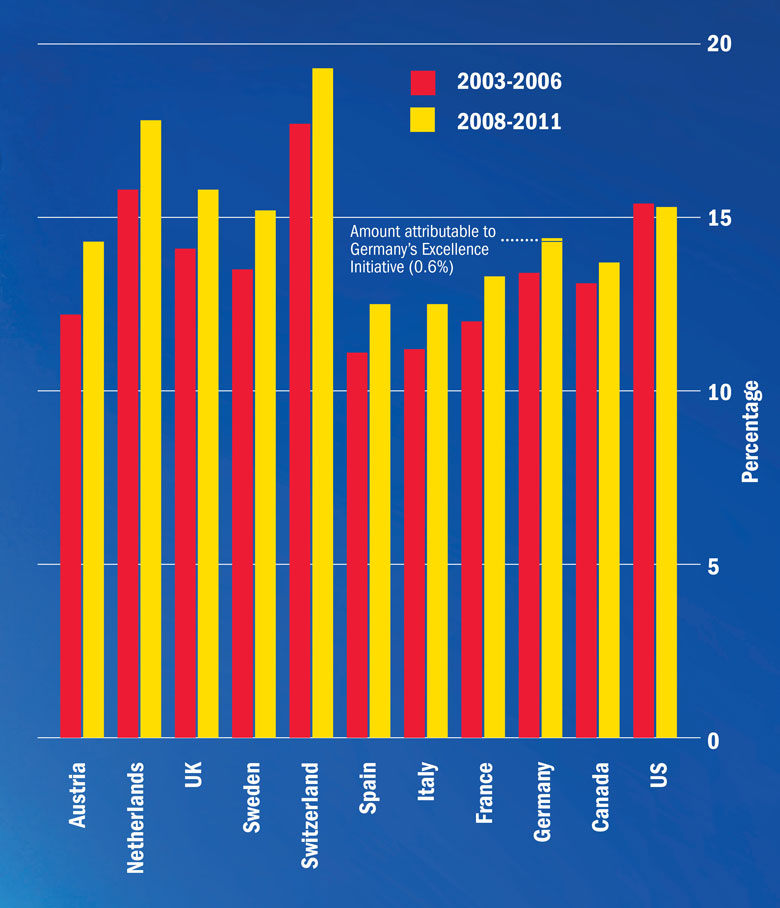Ten years ago, Germany started to shake up its traditionally egalitarian research system with the launch of the Excellence Initiative, which controversially began to concentrate funding into certain universities and research areas.
Worried about German universities’ weak showing in international rankings, and keen to create international “peaks” of top-notch research, policymakers hoped that the multibillion-euro project would deliver “excellence”.
The first analysis of papers specifically funded by the scheme suggests that they will be pleased with the results, according to Torger Möller, a researcher at the German Centre for Higher Education Research and Science Studies in Berlin.
The findings come as governments across the world grapple with the dilemma of whether to pour funds into a few select “elite” institutions to attract the world’s leading scientists, or create a broader base of research that allows new specialisms to emerge.
Dr Möller and two co-authors looked at around 6,000 papers funded by the Excellence Initiative’s “clusters of excellence” stream, which accounts for 60 per cent of the scheme’s total funding.
These clusters bring together research centres and universities to tackle challenges such as creating robots that make our daily lives more convenient, or the future of cultural relations between Europe and Asia. They are normally led by just one or two universities, but also bring in collaborators from Germany’s traditionally very strong non-university research centres, such as the Max Planck institutes.
Dr Möller’s analysis found that more than a quarter of papers that emerged from these clusters were highly cited – that is, they were in the top 10 per cent of cited publications globally. This performance exceeded even that of research coming out of Max Planck institutes themselves, seen as the strongest centres of research in Germany.
“In this respect, the CoEs [clusters of excellence] actually do produce internationally visible research to a high degree,” says the study, “Assessing the effects of the German Excellence Initiative with bibliometric methods”, published recently in Scientometrics.
But, it cautions, it is not clear whether this is the result of the funding injection creating genuinely new good research – as far as this can be measured by citations – or existing excellent work having been “bundled” together.
Proportion of papers that are highly cited
Note: Top science nations (>50,000 citable publications in 2003-06 and proportion of papers that are highly cited (top 10%) >10%), sorted descending by proportion of highly cited papers (top 10%) increase
Source: Scientometrics
The paper also shows that cluster of excellence publications have helped keep Germany in contention with other countries when it comes to producing highly cited research (see graph). As the first phase of the Excellence Initiative kicked in, Germany increased the proportion of its publications that are highly cited by 1 per cent, and 0.6 per cent of these highly cited articles were cluster of excellence-funded research.
These might sound like small numbers, and as the graph shows, other countries, notably the Netherlands, Australia and the UK, have seen bigger leaps in their research quality than Germany, despite the Excellence Initiative.
But, as the paper points out, despite sparking great debate in Germany over science policy, Excellence Initiative funding accounted for just 3.2 per cent of research expenditure in higher education between 2008 and 2010. “This puts into perspective any exaggerated expectations,” it says.
The initiative also set out to build bonds between universities and non-university research centres, whose lack of integration has been a concern in Germany since the 1990s. The Max Planck institutes, for example, focus on basic research and long-term projects, while Fraunhofer institutes concentrate on applied research and receive most of their funding from industry.
According to Dr Möller’s study, the initiative has succeeded, as clusters of excellence have encouraged collaboration between universities and Max Planck institutes, creating very high quality research.
The initiative has also shaken up Germany’s university culture, Dr Möller argued, because the launch of the initiative meant that German universities were spurred to compete for funding.
As well as clusters of excellence, the scheme also gives extra funds to a number of graduate schools and a handful of elite universities whose institutional strategies demonstrate that they can “compete successfully with the leading players in the international science arena”, according to the Deutsche Forschungsgemeinschaft, the funding organisation that helps to oversee the initiative.
“Universities start to think about what they want to do in the future, and establish research in special fields,” said Dr Möller. They can no longer “go on and go on” as they had always done, he said.
And because of the need to bid quickly for Excellence Initiative money, they have also had to become much faster at hiring academics, which previously could be a slow process, he added.
Register to continue
Why register?
- Registration is free and only takes a moment
- Once registered, you can read 3 articles a month
- Sign up for our newsletter
Subscribe
Or subscribe for unlimited access to:
- Unlimited access to news, views, insights & reviews
- Digital editions
- Digital access to THE’s university and college rankings analysis
Already registered or a current subscriber? Login






